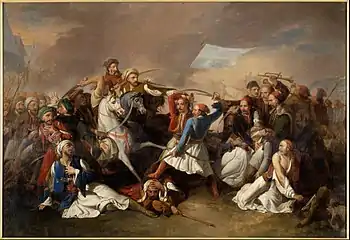Filippo Marsigli
Filippo Marsigli (1790 in Portici, near Naples – 1863) was an Italian painter, mainly of grand manner historic paintings in a Neoclassic style in Naples, Italy. He was a professor in the Academy of Fine Arts of Naples.
Biography
Along with Camillo Guerra, Gennaro Maldarelli, and Giuseppe Cammarano, in 1841 he helped fresco ceilings in the rooms of the Royal Palace of Naples. In 1825, his La Tomba dell'uomo da bene won a prize at a Neapolitan exhibition.[1] Marsigli completed the sala d’Amore, now the reading hall in the National library. In the four ovals, he depicted stories of the Hours and Cupid: Tersicore che invita le Ore alla danza, La danza delle Ore, Prigionia di Cupido, and Fuga di Cupido. The same coterie of painters decorated the apse of the Cathedral of Caserta.[2] His brother Giuseppe Marsigli was also a painter.

References
- Napier, Lord Francis (1855). Notes on Modern Painting at Naples.. West Strand, London: John W. Parker and Son. pp. 18.
- Arte in Italia: rivista mensile di belle arti, article by T. Pateras, page 118.
- Enciclopedia Treccani article on Marsigli.